Triptych of John The Baptist and John The Evangelist
Memling Museum, Old St. John's Hospital, Bruges
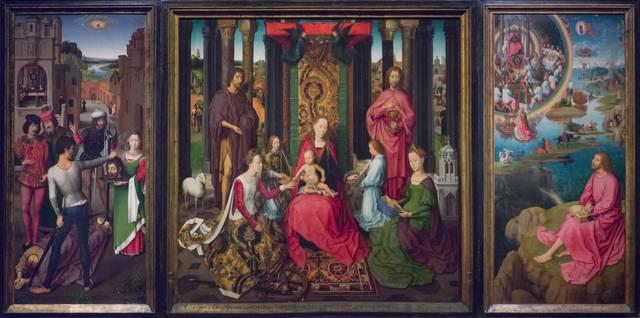
a major work by Hans Memling
the triptych of the Old St. John's Hospital in Bruges since the 15th century
The triptych has been conceived and realised for the master altar of the new apse of the church of the Old St. John's Hospital of Bruges (in Flemish: Brugge) built in -, where it still stands.
The frame bears the inscription « WORK OF HANS MEMLING », the first known signature of the flemish primitive painter of Bruges Hans MEMLING, and also the date: «».
It has a central panel, framed by two panels on the right and left fixed by hinges.
The characters depicted are a little smaller than life size.
about this article
objectives of this article
The article we are writing aims to go beyond this first glance:
- we describe in detail the quantities of small scenes that Memling arranged in the landscape by means of quality reproductions note 1,
- connect them to the sources, whether textual or pictorial, which it is reasonable to assume directly inspired Memling,
- let us reconstruct a narrative that accounts for its coherence as well as its unity,
- let us make available the texts we report on so that our choices can be judged.
Through this, we should enable the reader to become more familiar with Bruges society in the late 15th century, in particular:
- of the Christian wonder of Jacobus de Varagine's The Golden Legend,
- from the sensibility of this current of religious reform, called “devotio moderna”,
- of the economic opulence, urban social magnificence of the late 15th century Duchy of Burgundy.
Our aim will have been achieved if the reader finds himself in a position to measure and thus deepen his own perception of a work which we believe deserves to hold the attention so great is the brilliance of its presence.
outline of this article
In the following pages, we present the different aspects of this work:
- first by a photographic presentation of the work in its exhibition space, the new apse of the hospital church,
- then by a detailed description of what it represents,
- finally by the relating the various elements of the image to the various texts on which it is reasonable to assume that the painter himself relied in order to conceive his representation of religious subjects.
photographic presentation of the work in its exhibition space

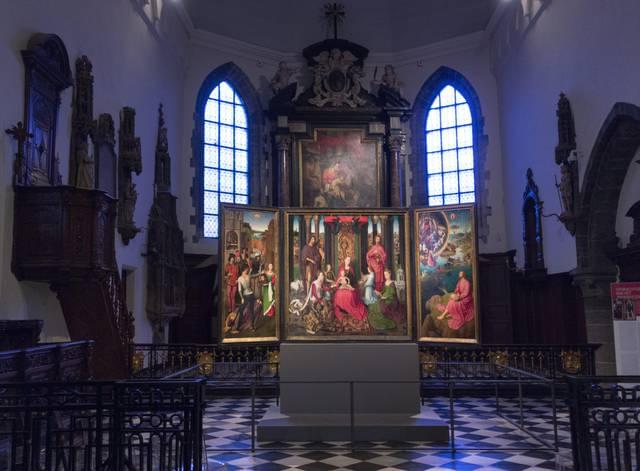

description of the work

We first describe what the work represents and for that we follow the path of the gaze, starting with the main scene.
coronation of the virgin
In the center, virgin Mary thrones on a gold seat in front of a clothed cloth and under a red velvet baldaquin.
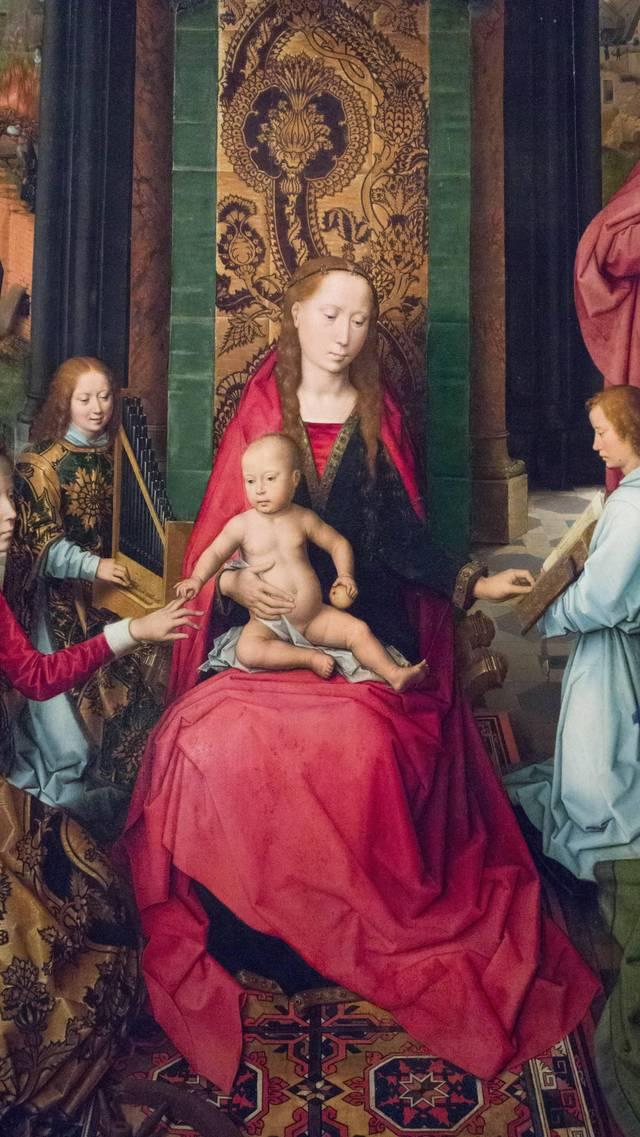
She is crowned “Queen of heaven” by two small dark blue angels flying above her.
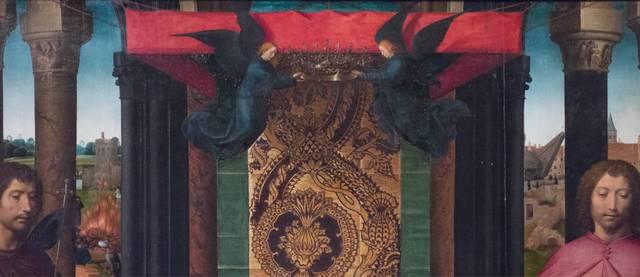
jesus child
On his knees, Jesus child, seatted, hold a apple with his left hand, and move from his right hand a ring to the finger of a woman, placed futher down and left of her, on the front.
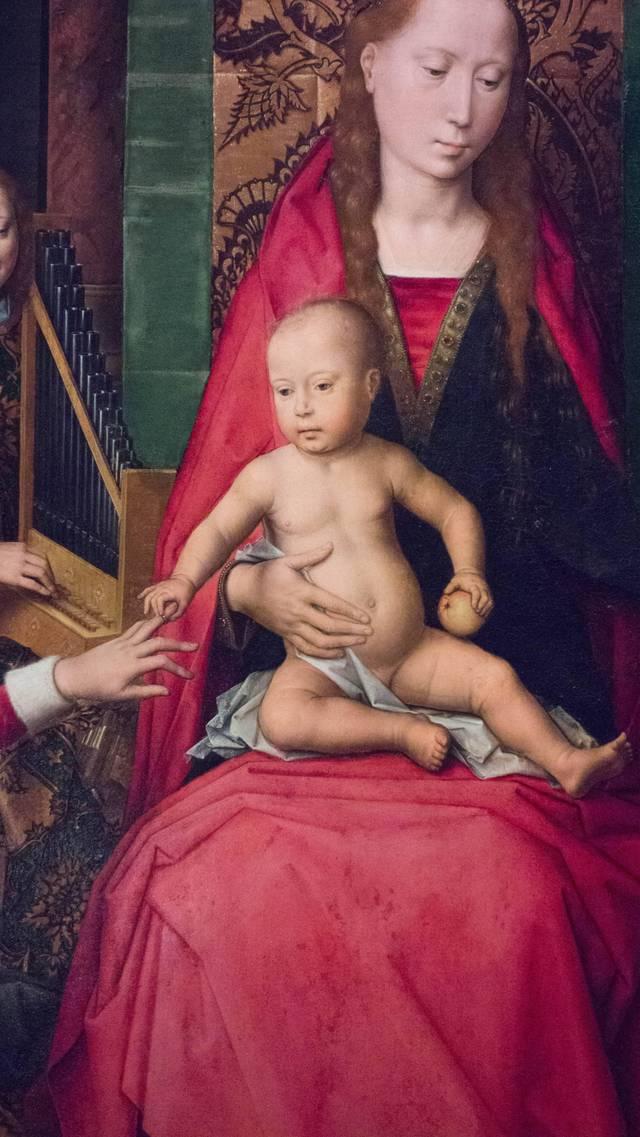
catherine of Alexandria
catherine of Alexandria in the scene of then central panel
The sword and the broken wheel at his feet are the instruments of his martyrdom: it is Catherine of Alexandria.

Catherine of Alexandria
Catherine of Alexandria was, since the end of the 13th century, a very popular saint whose legend, reported by Jacobus da Varagine in chapter 168 of The Golden Legend, entitled “Saint Catherine”, is fascinating.
read: text of the Legend of Catherine of Alexandria according to chapter 168 of The Golden Legend.
It is quite likely that Memling relied on this text.
Although modern historians believe that Catherine of Alexandria has not really existed note 2 and her cult was removed from the general calendar of the catholic church in note 3.
catherine of alexandria, her legend in the 15th century
According to her legend, Catherine is a patrician known for her exceptional education and her great beauty
She may have lived in Alexandria in the 3rd or 4th centuries.
She defies the roman emperor of the time, Maxentius, who then threatened christians with public abjuration.
Maxence is surprised by this extraordinary woman, who offends and humiliates him by the relevance of her conversation.
He struggles to maintain his dignity and, defeated at the end of a long spiritual battle full of twists and turns, proposes to her to marry him.
Catherine, in the name of her faith, refused and chose to undergo martyrdom.
At the time of his execution, Jesus' own voice would then have been heard from heaven to tell him:
«Come, my beloved, my beautiful one!»
Due to the presence of Saint Catherine, the triptych has sometimes been called “the mystical marriage of Saint Catherine” note 4.
the two john
two twins: john the baptist, john the evangelist
But more than Catherine of Alexandria, two men are the main characters of the work:
- the many details that tell their two legends throughout the interior of the triptych (central panelm, right and left shutters),
- both are called "John", which, in a hollow way, materializes in the work the commissioning institution, St. John's Hospital in Bruges and justifies the current official name, Triptych of John the Baptist and John the Evangelist.
they stand as twins, standing, right and left, on either side of the virgin, framed, on the back.
john the baptist
On the back, on the left, the presence of a white lamb allows us to identify the man wearing the magnificent purple tunic as John the Baptist.
The lamb recalls the words with whom John the Baptist presents Jesus, saying (John chapter 1 verse 29):
«Behold the lamb of god».
In fact, John also refers with his right arm to the child Jesus.

The lamb is a new symbol of the christian faith.
In contrast to the ancient hebraic faith, where, in order to please god, animals had to be sacrificed to him, christianity affirms that the only true sacrifice that pleases god is that which the believer makes of himself, in imitation of Jesus and in reference to this word of the prophet Isaiah (Isaiah, chapter 53 verset 7):
«afflicted he didn't open his mouth. As a lamb that is led to the slaughter».
Under his purple tunic is another tunic, light brown, which the text tells us is camel hair (Mark chapter 1 verse 6), imitating the hair garment of the prophet Elijah (2 Kings chapter 1 verse 8).
This same hair garment also refers to an episode of Genesis (Genesis chapter 27 verses 1 to 40) during which Jacob, on the advice of his mother Rebecca, poses as his brother Esau who is very hairy, with his blind father, Isaac, by wearing a hair garment.
His cunning allows him to be unduly blessed and thus become the sole heir in Esau's place. This tunic is also a sign of domination of animality, and in the case of John the Baptist, the camel being an animal that allows to cross the desert, of domination of animality by asceticism.
john the evangelist
On the other side, on the right, another man standing, dressed like a priest, in red, makes with his right hand the sign of the cross on a cup, in which there is a serpent: it is John the Evangelist.

We recognize John the Evangelist as an episode of the The Golden Legend (chapter 9), which we report here.
John faces Aristodemus, priest of the temple of Diana in Asia (probably Ephesus), who publicly challenges him to drink a poisoned cup.
The later makes, as Memling represents him, the sign of the cross, drinks the cup but the poison does him no harm.
The serpent also refers to a word that Jesus addressed to Nicodemus (John chapter 3 verses 14 to 15):
“As Moses lifted up the serpent in the wilderness, even so must the Son of Man be lifted up, that whoever believes in him should not perish, but have eternal life.”.
the name «john», its link with the institution, its etymology
the etymology of the name «John» in Hebrew
The etymology of the first name "John" comes from the hebrew «Yokhanan», whose pronunciation is:
which literally means «god» is «grace» or «mercy».
As «god» also means in hebrew «what is», it also means «the one who is» «grace» or «mercy».
Although this first name was used by several minor figures in the history of the hebrew people, it only became very popular after the appearance of christianity in the christian world, following the very important role each of them played, roles that we will soon detail.
Barbara the Great Martyr
Barbara the Great Martyr in the scene of the central panel
On the other side of virgin Mary, on the front right, another woman, dressed in a magnificent green wool tunic as only Bruges produced in the 15th century, reads.
Her presence corresponds to that of Catherine of Alexandria on the front of the other side.
Behind her, a white stone tabernacle tower tells us that it is Barbara the Great Martyr note 5.
As with Catherine of Alexandria, modern historians doubt the reality of her existence and her name has also been removed from the general calendar note 3.
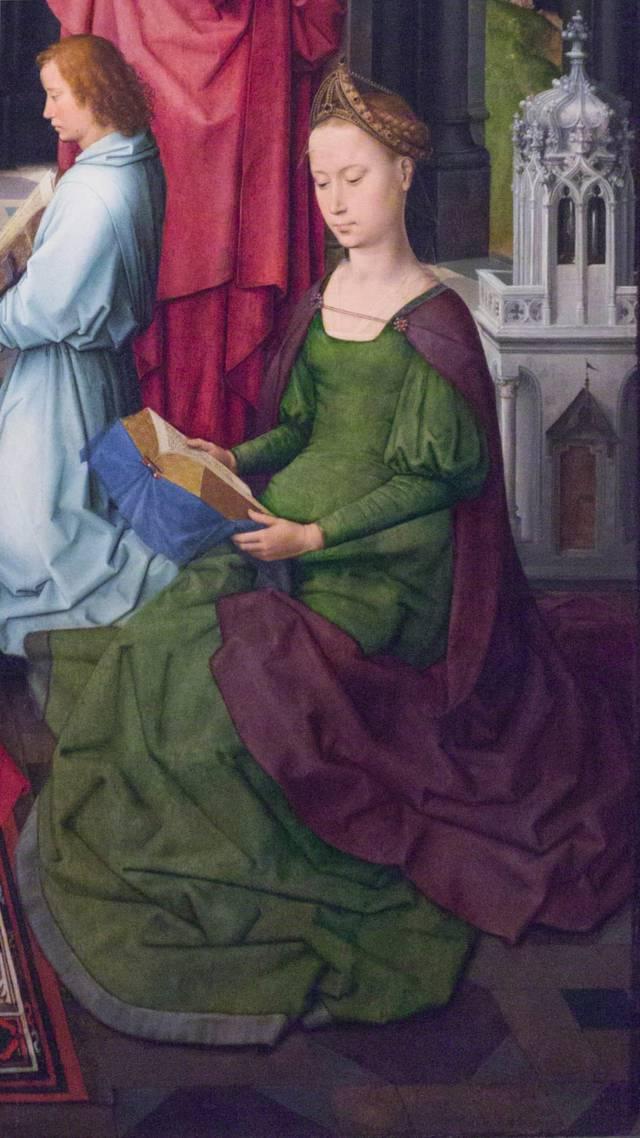
Barbara the Great Martyr, its historical reality
The text Memling relied on to represent her is also not part of The Golden Legend but, like other texts, was added to it later.
read: text of the Legend of Beard the Great Martyr added to The Golden Legend.
Barbara the Great Martyr, her legend in the 15th.
According to his legend, Barbara lives in Nicomedia, capital of the former province of Bithynia, which is located in the north of present-day Turkey and overlooks the Black Sea. Barbara has the defect of being beautiful..., so beautiful, that when he was very young, his father emprisoned her in a tower!
The text teaches us that Barbara then feels «the nothingness of earthly things» and begins to worry about «heavenly things». Although it was forbidden in her time, she gradually turned away from the roman gods and secretly wrote to the most famous christian of Alexandria in Egypt, Origen. The latter replied, fortifying her in her nascent faith, visiting her and secretly giving her the baptism.
Publicly denounced later for refusing to sacrifice to the gods, she was martyred. Jesus' voice would then have been heard from heaven:
«Come, my beloved; rest in my father's house in heaven».
His own father cuts off her head.
the host through the tower of Barbara the Great Martyr
Through the intertwining of the tower, a host appears in a glass cylinder mounted on a golden crescent moon.
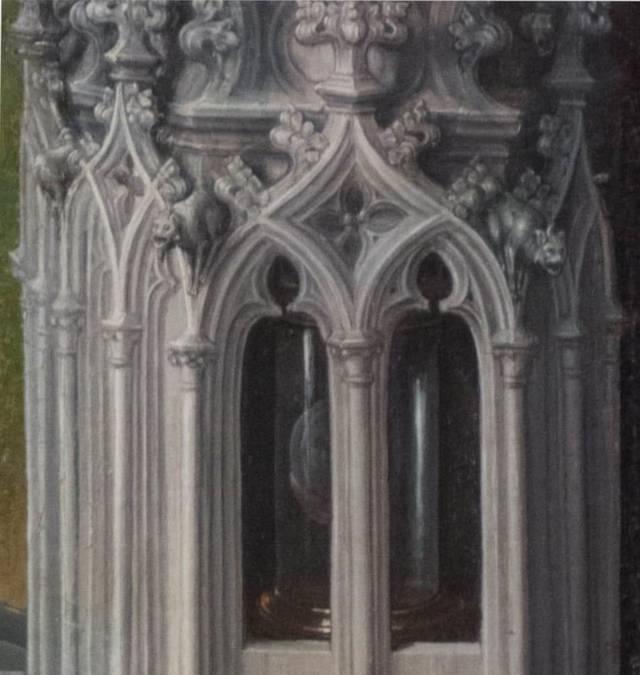
The host is one of the attributes of the saint; it is also a link with the rest of the panel that reveals other aspects of it in the form of a «sacred conversation».
a sacred conversation
sacred conversation in the central panel scene
To Mary's coronation, the presence two by two of Catherine of Alexandria and Barbara the Great Martyr, John the Baptist and John the Evangelist adds a «sacred conversation», that is, a meeting of saints around the Virgin.
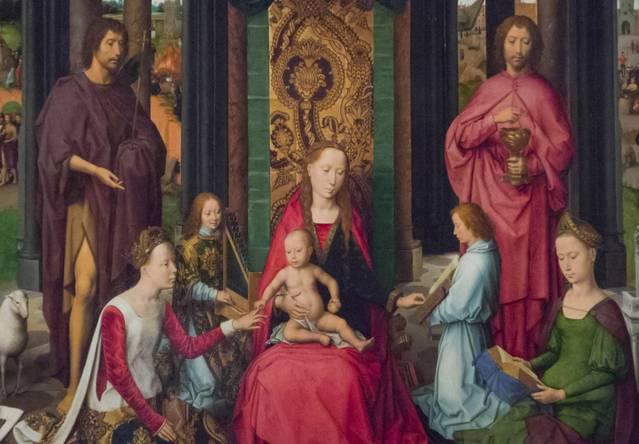
the two altar servers in the scene of the central panel
This spirit of communion is reinforced by the presence:
- on the left of the Virgin of a altar server who plays a small organ seated,
- and on the right of another kneeling who presents her with a book.
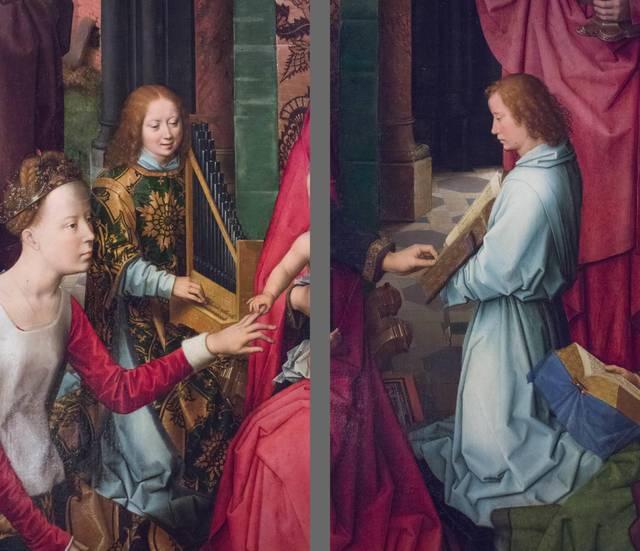
Sacred conversation, a remarkable expression of “devotio moderna”
symmetry, simplicity, distinction in the arrangement of the protagonists
symmetry, simplicity
The symmetry and simplicity of the positions in relation to each other in the width matches the shape of the tryptic.
distinction
The height and depth organize themselves around the distinction between men and women:
- on the front below, two women,
- on the back in the upper part, two men.
The unfathomability and mystery in depth and height responds to the symmetry and simplicity of the width positions
similarities of physiognomies, variety of ages represented
The characters depicted appear to be from the same family and are of all ages:
- newborn,
- small child,
- child,
- teenager,
- young man,
- woman,
- mother,
- man,
- mature man and woman.
The similarity of the physiognomies and the variety of ages unifies the whole.

“devotio moderna”, a movement to reform the Christian faith in Flemish society in the 15th century
We believe that this balance is a remarkable feature of the 15th century Flemish society in which Memling lived.
The very important Christian faith reform movement of this period, which historians call “devotio moderna”, illuminates that familiar simple transparency of represented space.
“devotio moderna”
In Flanders, at the time of Memling, for a book of Christian piety, “The imitation of Jesus Christ”, is a huge publishing success note 6 .
text from The Imitation of Jesus Christ
One can read:
- Man rises above the earth on two wings, simplicity and purity.
- Simplicity must be in intention, and purity in affection.
- Simplicity seeks God, purity finds him and taste him.
- No good work will be difficult for you if you are free of any disturbed affection.
- If you only want what God wants and what is useful to the others, you will enjoy inner freedom.
- If your heart was right, then any creature would be a mirror of life to you and a book filled with holy instructions.
- There is no creature so small and so vile that would not present some image of the goodness of God.
- If you had enough innocence and purity, you would see everything without impediments.
- A pure heart penetrates heaven and hell.
- Anyone judges of things from the outside according to what he is within himself.
- If there is some joy in the world, the pure heart owns it. And if there are anxieties and tribulations, above all they are known from bad conscience.
- As the iron put on fire loses its rust and becomes blazing, so the one who gives himself unreservedly to God remains his languor and changes into a new man.
In the scene depicted by Memling, the sacred conversation functions in the terms of the text quoted above as a book filled with holy instructions
simple, pure, in accordance with the architectural plan.
architectural plan
the “devotio moderna”, mode of relationship between the protagonists of the represented scene and spectators
The arrangement of the places represented, the apse of a church, allows the architectural device to function also in relation to the spectators of the triptych.
We who look at the painting find ourselves de facto in the space of the painting, part of the sacred conversation, in the presence of the protagonists of the scene represented, in this relationship of simple, transparent, familiar otherness.
From this point of view, Memling's work functions as a mirror of life:
- On the one hand the viewers of the triptych, whether they were patients at St John's Hospital in Memling's time or us today “conversing” with the figures depicted,
- on the other these “act” here and now, as Bruges men and women of or visitors to the Memling Museum of the 21st century.
devotio moderna, crystallisation of the marvellous of Bruges in the 15th century
Finally, the exemplary arrangement of a representation in which the figures are adorned with the finest sartorial achievements of 15th century Bruges, crystallises the sense of wonder.
spiritual simplicity, evidence, ideality also produce in a continuous way material sophistication and opulence.
Dirk DE VOS mentions:
“a world of virgins clad in gold brocade, silk and ermine, golden crowns and rare precious stones” where "the infant Jesus beckons" to the sick in an "atmosphere imbued with profound serenity".
In fact, in Bruges in the 15th century, simplicity and the obvious knew no bounds, leading wonderfully to the divine.
the influence of Van Eyck on the architectural plan
Memling is undoubtedly guided by this work by Jan VAN EYCK painted in , which he knows and will admire in the St. Donatian Cathedral: “Virgin and Child with Canon van der Paele”.
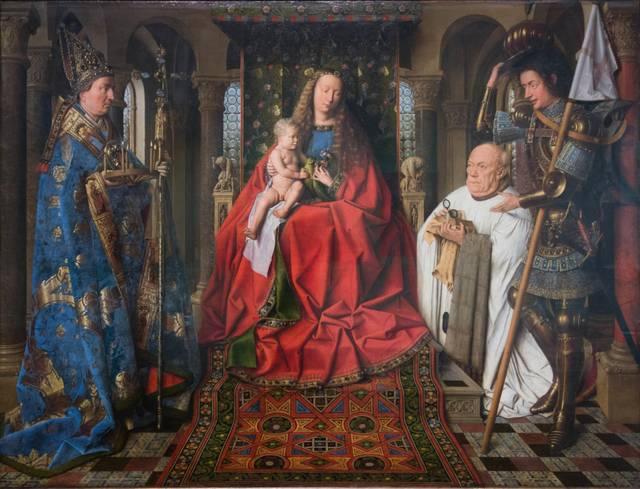
Memling's innovation on the architectural plan compared to Van Eyck
As in many of his other works, Memling removes to the apse walls, windows and makes the view to the outside continuous.
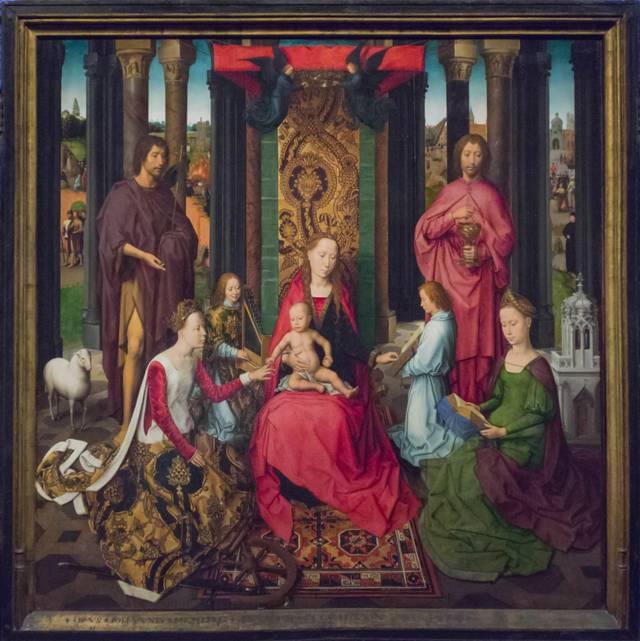
Six columns marbled with red and brown are arranged in a semi-circle on a tile and doubled on the outside by a second semi-circle of fasciculated dark grey pilasters. Their bases are connected by the edge line of the paving which shows a polygon on the ground.
The thin vertical openings between the columns overlook a visually continuous landscape with ruins and buildings, open to the distant, horizon and infinite.
organisation of the pictorial narrative around the legends of John the Baptist, John the Evangelist and the Old St John's Hospital
a number of small scenes
The narrative is structured around a number of small scenes
- depicting the two legends,
- of John the Baptist
- and John the Evangelist
- and representing the Crane's square of Bruges linked to the St. John's Hospital.
the narrative begins with the capitals of columns
The two legends begin spatially with the sculpted scenes above each saint in the column capitals.

the narrative continues with small scenes in the distance
This manner of ordering the composition, which is found in many of Memling's other works, takes up the layout techniques of illumination note 7: the various scenes are tiered up to a very high placed horizon.
Small scenes take place in the distant within the various framings operated by the columns.

on the left, scenes from the Legend of John the Baptist, on the right, those of John the Evangelist
the narrative concludes with each of the two inner shutters
The narrative of the two legends then continues in each of the two inner panels.

On each shutter, an episode forms a main scene in the foreground, completed in the narrative by small scenes in the distance.
- on the left inner shutter, John the Baptist has just been beheaded by Herod's order,
- on the right inner shutter, John the Evangelist receives the «unveiling» of the text of The Revelation in Patmos.
Crane's square, symbolises the St. John hospital
The view from the Crane's square and St. John's Church, in the background to the right of the drapery of honour behind the virgin, behind John the Evangelist refers directly to the religious leaders of the hospital sponsors of the work and to the history of the commissioning institution.

Two brothers from the hospital are represented measuring the imported bordeaux wine arriving in Bruges.
This reminds us that the hospital was entrusted by the city around with a communal charge, the «right to gauge» from which the institution had its income.
scenes from the legends of John the Baptist and John the Evangelist according to The Golden Legend
We follow here each of two stories on which Memling probably based himself as Jacobus da Varagine reports them in The Golden Legend.
As, in the scenes Memling painted, these texts are faithfully represented, we invite those who would like to feel more deeply the relationship of the triptych to the various texts to read them directly:
- read: text of the Legend of John the Baptist from chapter 9 of The Golden Legend,
- read: text of the Legend of John the Evangelist before the Latin Gate from chapter 65 of The Golden Legend.
scenes from the legend of John the Baptist according to The Golden Legend
We begin with John the Baptist who, in chronology, precedes John the Evangelist.
In the upper left corner of the background of the central panel and on the left inner shutter appear scenes of his life and martyrdom.

John the Baptist according to historical documents
Historically, John is described as a jewish preacher in Galilee of this time of Jesus of Nazareth according to the testimony of Flavius Josephus, a 1st century roman jewish historian (“Jewish Antiquities”, book XVIII, chapter 5, paragraph 118).
Galilee at that time was a province of the roman empire that experienced many revolts.
Its population, mainly jewish, is very religious; the biblical writings announce the coming of an envoy of god whose action will enable the jewish people to recover their independence and religious organization, in particular to rebuild Solomon's temple in Jerusalem.
John the Baptist according to the texts of the Christian faith
In terms of christian faith, John is, according to Luke's gospel (chapter 1 verses 5 to 25), the son of Zechariah, an old jewish priest from the galilean countryside to whom god himself announces by the archangel Gabriel the birth of John when he was chosen by chance to go to Jerusalem and prays in the temple.
Scene of Gabriel's appearance to Zechariah on the left capital
That's how Memling represents him on the left capital.

The text indicates that because of that Zechariah loses his ability to speak.
Scene of the birth of John on the right capital
His birth is represented on the capital placed on the right.
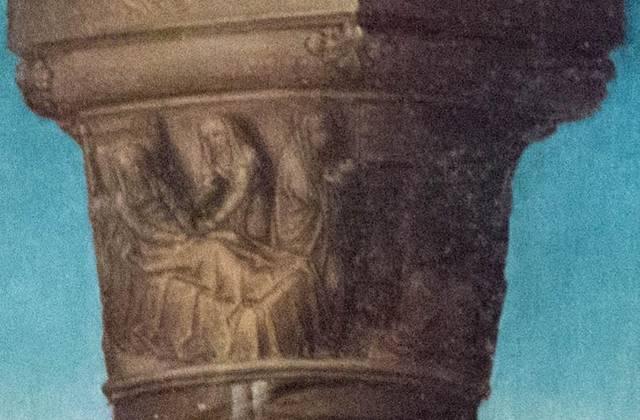
Choice of the name of John by Zechariah
The name of this son, «John», is also one of the issues in the story (Luke chapter 1 verses 59 to 63):
«It happened on the eighth day, that they came to circumcise the child; and they would have called him Zechariah, after the name of the father. His mother answered,
“Not so; but he will be called John.”
They said to her,
“There is no one among your relatives who is called by this name!”
They made signs to his father, what he would have him called.
Zechariah asked for a writing tablet, and wrote,
“His name is John.”»
From the point of view of faith, John the Baptist therefore comes into the world according to god's will.
Scene of the asceticism of John in the distance of the central panel
He then leads an exemplary life as an ascetic «in the desert» (Luke chapter 1 verse 80).
Memling transposes this scene into the forest.
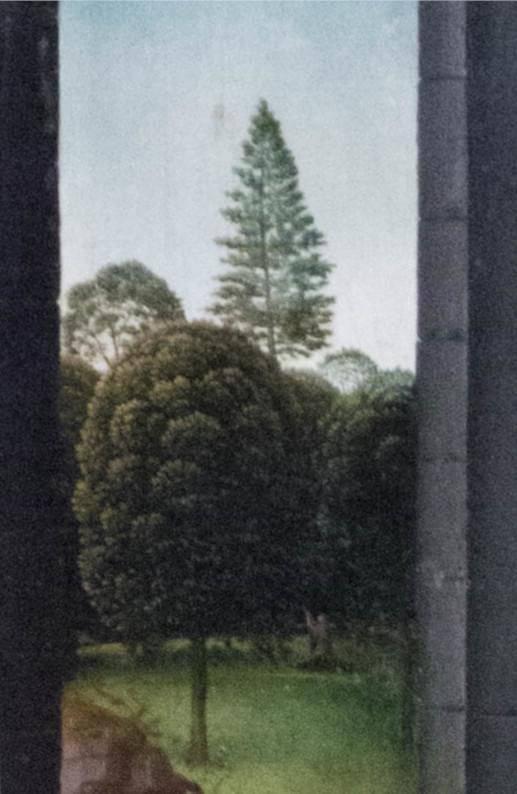
Scene of the apostolate of John in the distance of the central panel
We also see him preaching the baptism of repentance for remission of sins
(Luke chapter 3 verse 3).
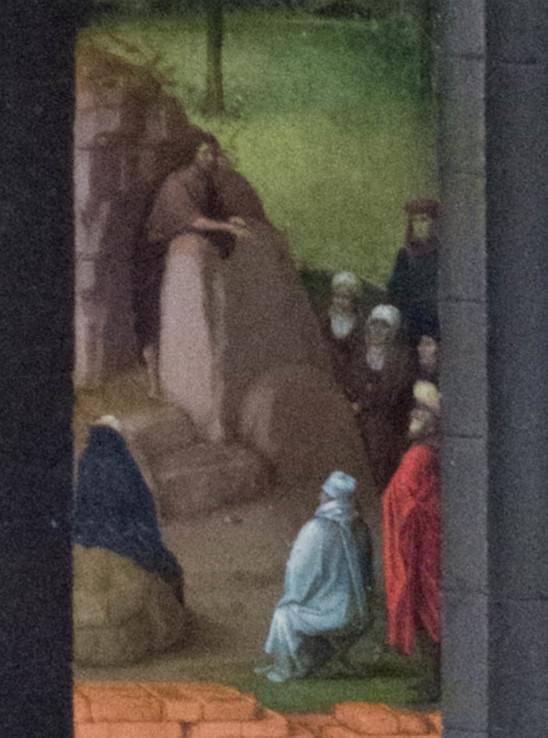
preaching the baptism of repentance for remission of sins”
John innovates in the judaism of his time.
He advocates the forgiveness of sins no longer through the sacrifice of animals in the temple by cremation, but by «baptism», that is, according to the etymology of the word, «immersion» in water.
Scene of John the Baptist baptizing Jesus on the banks of the Jordan River in the far left inner shutter
According to the biblical writings, he announces the coming of god's envoy in the person of Jesus of Nazareth, one of his contemporaries.
He recognizes it by a baptism in the waters of the Jordan: this scene appears at the top of the left inner shutter.

On the other bank, John the Baptist presents Jesus with the words Behold the lamb of god
to his first two disciples Andrew and John the Apostle; they join him.
Scene of the arrest of John in the distance of the central panel
From that point on, his story turns to tragedy.
The tetrarch of Galilee and Perea, Herod Antipas married «his brother Philip's wife (Herodias)» (Mark chapter 6, verse 17);
As the jewish faith regards any marriage with his brother's wife as «defiling» and forbids it (Leviticus chapter 18 verse 16; chapter 20 verse 21), John publicly condemns it.
Herod feared that this would provoke «a revolt, the crowd seeming ready to follow all the advice of this man.
He therefore prefers to take him before any trouble occurs because of him, rather than to have to repent later if a movement takes place» (Jewish Antiquities, Book XVIII, chapter 5, paragraph 118).
In the event of unrest caused by John's supporters, Herod had to answer to the roman authorities, who could dismiss him:
he gives “the order to arrest John” (Mark chapter 6, verse 17).

On the central panel above the white lamb, John was forcibly taken to the prison on the left side of the current city of Machaerus, whose ethymology in ancient greek means «sword» and which is located in present-day Jordan.
Overview of the left inner shutter
The action continues on the left inner shutter.
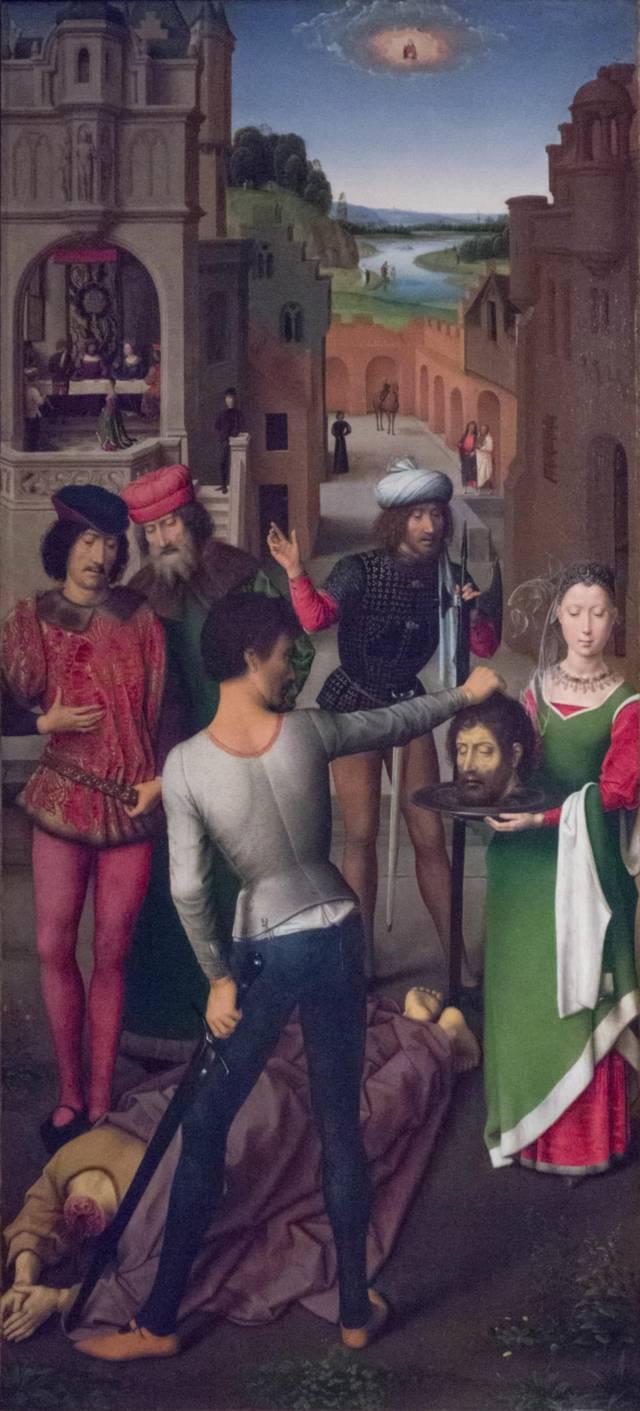
Scene of Salome's dance in Herod's palace, inside left shutter
To succeed in making John die without causing any troubles among his supporters, Herod imagined a staging:
«on his birthday», he organized «a dinner for his dignitaries, for the chiefs of the army and for the notables of Galilee.
Herodiade Salome's daughter» makes «her entrance» and dances.
The "Dance of Salome" takes place in a room in the tower of Herod's palace at the upper left of the left shutter, the wall of which Memling gutted to show the scene.
Above, statues set in niches represent a naked man between two naked women, pagan figures who allude to Herod's adulterous behaviour.
Overhead, statues set in niches depict a naked man between two naked women, pagan figures: they qualify the adulterous nature of the place and Herod's behavior.
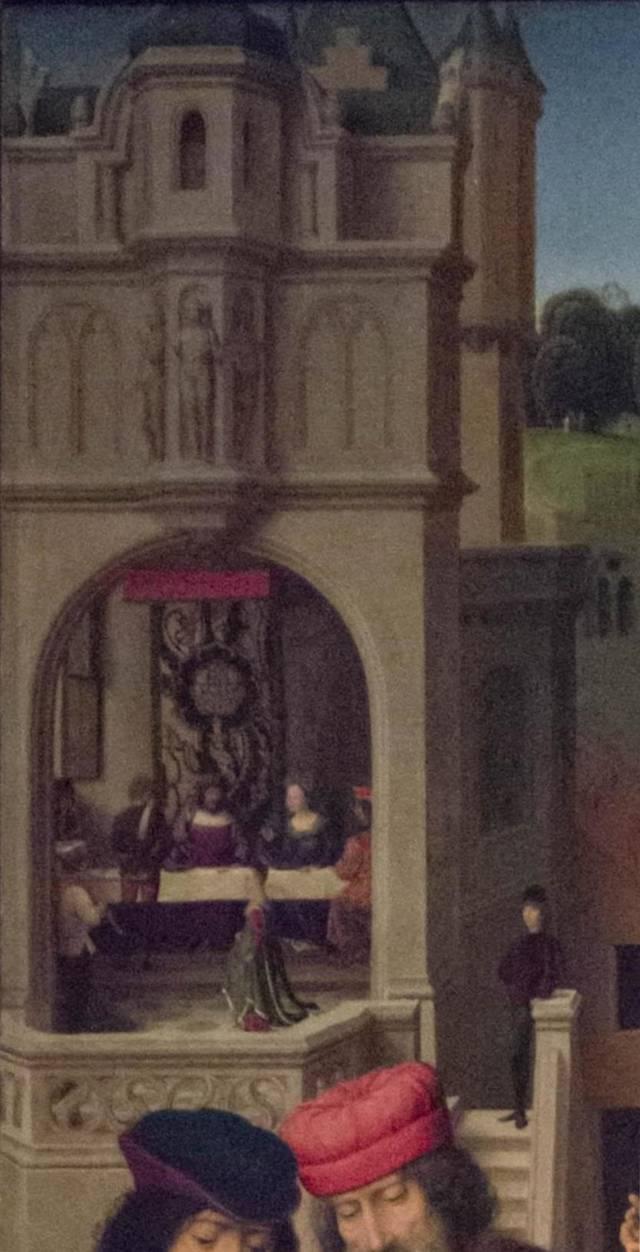
Herod looks as if he liked his dance and, to avoid responsibility for John's death, says (Mark, chapter 6, verses 22 to 25):
«“Ask me whatever you want, and I will give it to you”.
He swore to her,
“Whatever you shall ask of me, I will give you, up to half of my kingdom.”
Salome went out, and said to her mother,
“What shall I ask?”»
Herodias said,
«“The head of John, the one who baptises”.
She came in immediately with haste to the king, and asked,
“I want you to give me right now the head of John the one who baptises on a platter.”.
Thus Herod can appear to put John to death against his will.
The proof that this whole story is indeed a smokescreen designed to allow John to be put to death without provoking a revolt by John's supporters is, as Jacobus da Varagine explains, that if Salome asks Herod «the death of her father Philip or her mother Herodias», Herod cannot consent to it (The Golden Legend chapter 121, paragraph I. note 8 ).
The only purpose of the smokescreen is indeed to avoid placing the responsibility for John's killing on Herod by falsely presenting him in the eyes of history as acceding to this request against his will.
Scene of the beheading of John in the courtyard of Herod's palace, from the inner left shutter
So history is accomplishing itself, tragically.
A guard is going to «behead John in the prison» (Mark, chapter 6, verse 28).

Detail of the decollation of John the Baptist, inside left shutter
Memling has enlarged the scene in the foreground of the left shutter: we are in the inner courtyard of Herod's palace.
The execution site in the fortress is connected to the palace by a staircase in the background.

To the left of the executioner depicted from behind are the two disciples Andre and John the Apostle.
Memling's inspiration on Van Der Weyden for the scene of the beheading of John the Baptist, inside left shutter
The executioner is represented from behind placing the head in the plate presented to him by a barely moved Salome.
Art historians have identified in the positions of the executioner and Salome a reuse by Memling of a similar scene in a work by his master when he was the assistant of this painter in Brussels, Rogier VAN DER WEYDEN.
This is the left inner shutter of the Tryptic of St. John painted around - in the Painting Gallery of the Berlin State Museums (inventory reference: 534B).
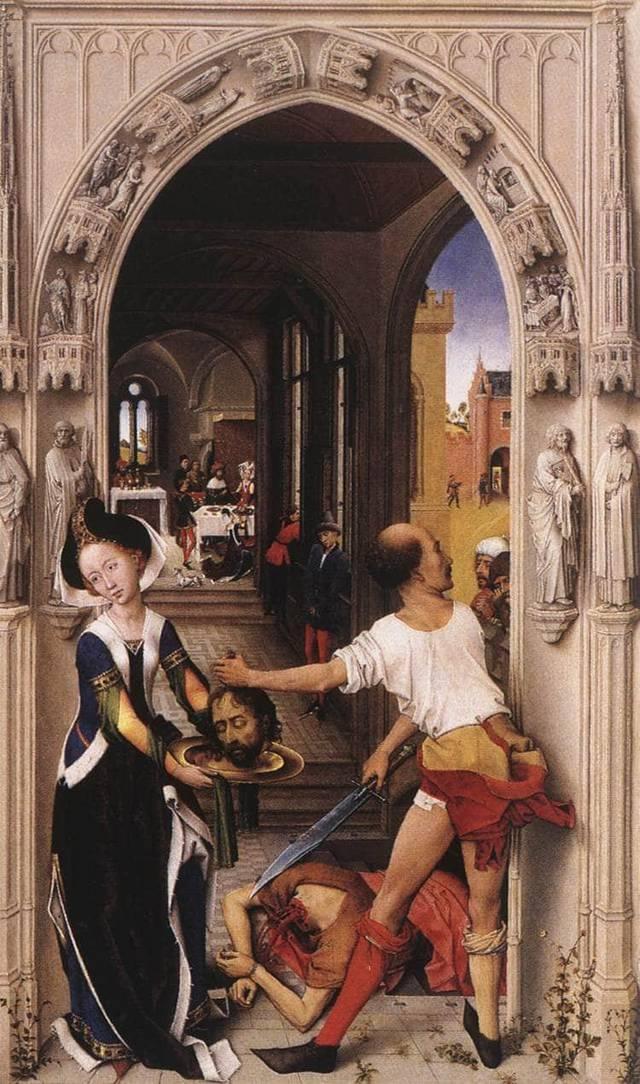
Scene of the incineration of the body of John the Baptist in the background, inner central panel
Mark's narrative continues: When John's disciples heard this, they came and took up his corpse and laid it in a tomb
(Mark, chapter 6, verse 29).
According to tradition, this one was taken away from the territories controlled by Herod Antipas, to the West Bank in Sebastee, the actual village of Sebastia and buried with the prophets Elisha and Abdias.
On the left of the central panel, on the right, behind John the Baptist, Memling has made this last scene of his legend appear.
As his miracles kept occurring at John's burial site, to combat the nascent Christian faith, Roman Emperor Julian the Apostate ordered the body to be dug up, burned, and his ashes scattered across the fields.
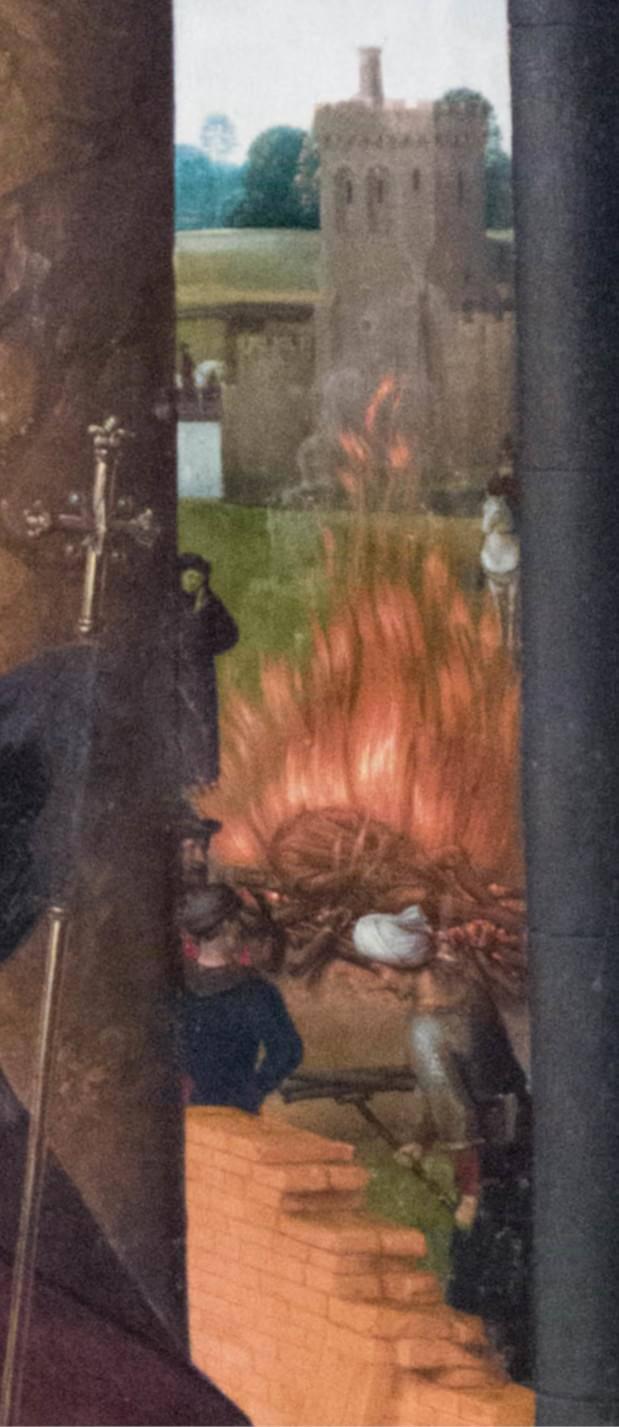
Detail of the wall in which the head of John the Baptist is hidden, inner central panel
His head appears lower down in the opening of the wall, behind a stone.
But things do not go as planned.
According to legend, the head was buried separately by a potter from the city of Emesse, the present Homs in Syria, and then is thought to have appeared to Saint Marcellus who discovered it by following a star (The Golden Legend chapter 121, paragraph III.).
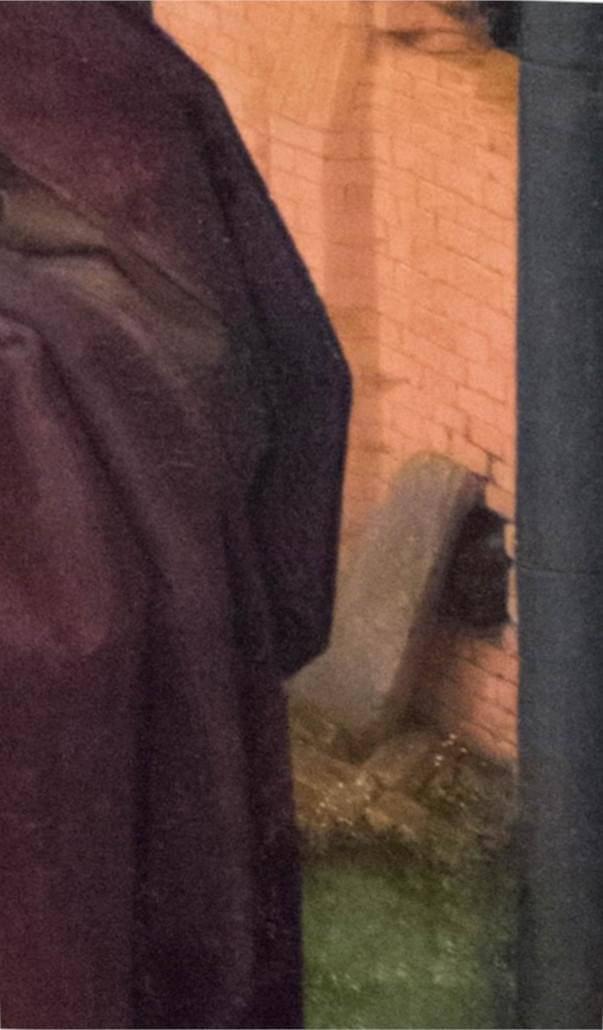
Thus ends the account of the legend of John the Baptist according to The Golden Legend.
scenes from the legend of John the Evangelist according to The Golden Legend and The Revelation
details on John the Evangelist according to The Golden Legend and The Book of Revelation
On the central panel in the upper part on the right of the background appear some scenes of the legend of John the Evangelist.
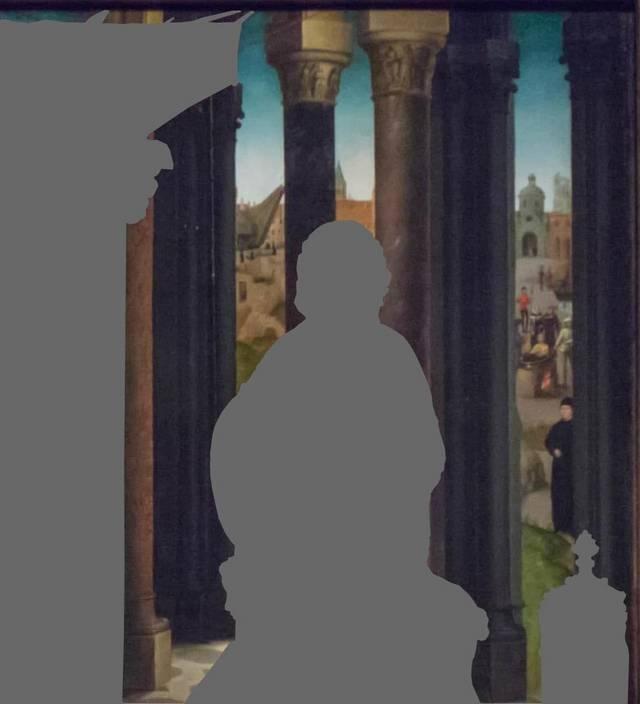
details on John the Evangelist according to The Golden Legend and The Revelation
Unlike John the Baptist, historically there is no historical document other than those of the Christian faith.
According to these documents and modern specialists, John the Evangelist can designate:
- John the «Apostle» who appears in the gospels of Mark, Luke, Matthew and the Acts of the Apostles,
- the disciple whom Jesus loved to write the gospel called «of John»,
- John «of Patmos» writer of the text of The Revelation.
We summarize the differences that distinguish these characters below.
John the “Apostle”
John «the Apostle» is one of the two «sons of Zebedee» (Mark chapter 3 verses 16 to 19, Matthew chapter 10 verses 2 to 5 and Luke chapter 6 verses 13 to 16).
- His brother is James, known as «the Greater».
- Jesus called them the «sons of thunder» (Mark chapter 3 verse 17).
- Like his brother and two other apostles, Simon Peter and Andrew, he is one of the fishermen of Lake Tiberias who abandoned his nets to follow Jesus.
- From there, he witnessed:
- the transfiguration of Jesus (Mark chapter 9 verse 2, Matthew chapter 17 verse 1 and Luke chapter 9 verse 28),
- the healing of Simon Peter's mother-in-law (Mark chapter 1 verse 29),
- the healing of Jairus' daughter the ruler of the synagogue (Mark chapter 5 verse 37 and Luke chapter 8 verse 51),
- was present with his brother when Jesus was tempted to renounce in the Garden of Gethsemane (Mark chapter 13 verse 3), but he fell asleep (Mark chapter 14 verse 33).
the disciple whom jesus loved
-
The disciple whom Jesus loved appears at the end of the gospel called «of John» (John chapter 21 verse 20; verses 24 to 25):
“Then Peter, turning around, saw a disciple following. This was the disciple whom Jesus sincerely loved.”
(…)
“This is the disciple who testifies about these things, and wrote these things.”
There is nothing in the text that allows us to call him «John», so the designation “Gospel of John” cannot be right: it should be the “Gospel of the disciple whom Jesus loved”.
He is quite an extraordinary character: he is a disciple of Jesus among others with whom every reader can identify, he is loved by Jesus himself and therefore finds himself closer to him than anyone else.
He does not hesitate, just after the previous excerpt, to give his opinion (John chapter 21 verse 25):
“There are also many other things which Jesus did, which if they would all be written, I suppose that even the world itself wouldn't have room for the books that would be written.”
-
Jesus himself, on the occasion of a question from Peter, expresses a wish for his destiny at the Last Supper (John chapter 21 verses 21 to 23):
Peter seeing this disciple, said to Jesus,
“Lord, what about this man?”
Jesus said to him,
“If I desire that he stay until I come, what is that to you?”
-
It is also him who
had also leaned on Jesus' breast
, he asks him who will betray him (John chapter 13 verses 25). -
At the crucifixion, Jesus entrusted his own mother to him, saying (John chapter 19 verses 26 to 27):
“Woman, behold your son!”,
Then he said to the disciple,
“Behold your mother!”.
-
When Mary Magdalene discovered the empty tomb, she ran to tell the «beloved disciple» and Peter; he was the first to reach the tomb (John chapter 20 verses 2 to 8).
-
He was the first to recognize Jesus at Lake Tiberias after his resurrection (John chapter 21 verse 7).
john of patmos
John of Patmos appears at the beginning of the text of The Revelation which presents him as (The Revelation chapter 1 verses 1 to 9):
a
servant
to whom god (…)sent and made known by his angel
(…)the things which must happen soon
(…)to the seven churches in Asia Minor
.
john the evangelist in relation to The Golden Legend
The representation of John the Evangelist broadly follows the account established by Jacobus da Varagine in Chapters 9 and 65 of The Golden Legend.
- read: text of the Legend of John the Baptist from chapter 9 of The Golden Legend,
- read: text of the Legend of John the Evangelist before the Latin Gate from chapter 65 of The Golden Legend.
john the evangelist scalded by order of emperor domitian in front of the latin gate in rome and departure for exile in the island of patmos
The narrative starts on the central panel (chapter 65):
- «John was preaching at Ephesus when he was arrested by the proconsul and invited to sacrifice to the gods.
- As he refused, he was thrown into prison; a letter was then sent to the Emperor Domitian designating him as a sacrilegious magician, contender of the gods and worshipper of the Crucified.
- By order of Domitian, John was then taken to Rome where, after having derisively cut his hair, in front of the gate of the city called «Latin», he was flogged and thrown into a cauldron of boiling oil under which a fiery fire was burning».
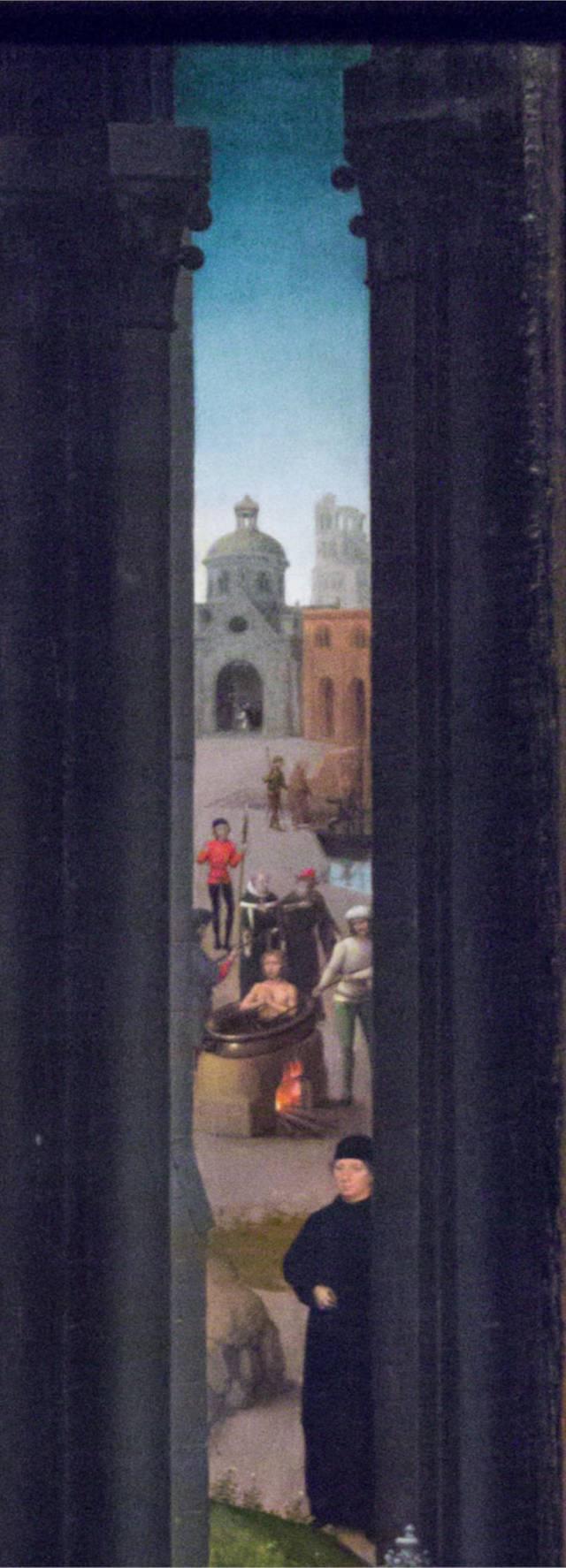
- «But John felt no pain and came out completely unscathed, not burnt but anointed. In this view, Domitian was stunned and feared to put him to death. So, in this place, Christians have built a church, and today is solemnly celebrated as that of John's martyrdom.».
The representation of Memling shows on the horizon on the left, this church, on the right, the Colosseum of Rome and the Latin Gate.
- «The emperor, realizing that he was not renouncing preaching, exiled him to the island of Patmos», (the departure for Patmos appears in the middle: some men board a boat) «where, in solitude, he wrote The Revelation» (chapter 9).
Overview of the right inner shutter: John bears witness to The Revelation in Patmos.
The right inner shutter is entirely dedicated to the visions John had in Patmos note 9 .
Memling's representation is particularly noteworthy because while there are many representations of The Revelation as a succession of paintings, in contrast there are very few that assume a unity of the space of representation.
And for good reason: the narrative of John of Patmos presents a remarkable complexity.
And yet Memling succeeds in the tour-de-force of making the space of representation as credible, supernaturally complex as the narrative.

Immediately I was in the Spirit. Behold, there was a throne set in heaven(…) Before the throne was something like a sea of glass, similar to crystal», The Revelation, excerpts of chapters 4 to 12.
Memling represents the apostle, sitting on a circular rock, the island of Patmos in the middle of the Aegean Sea.
He holds a feather and a penknife in his hand, and on his knees one can see a notebook.
John is represented when he has not yet even begun to write, in the blink of an eye, at the very moment when he is seized by the «Apocalypse», which in ancient Greek means «unveiling» and has been translated into «revelation».
these visions appear above him in the sky, on the water and on the nearby land on all the rest of the shutter.
We choose to follow John's own way to tell the unveiling in the text (The Revelation chapter 4 verse 2 and verse 6), which begins at the top left of the shutter: this way it is possible to compare the text with Memling's representation of it.
Vision of the throne of god, the heavenly court and the lamb - The Revelation, chapters 4 verse 2 to chapter 6 verse 1
chapter 4
- Immediately I was in the Spirit. Behold, there was a throne set in heaven, and one sitting on the throne
- that looked like a jasper stone and a sardius. There was a rainbow around the throne, like an emerald to look at.
- Around the throne were twenty-four thrones. On the thrones were twenty-four elders sitting, dressed in white garments, with crowns of gold on their heads.
- Out of the throne proceed lightnings, sounds, and thunders. There were seven lamps of fire burning before his throne, which are the seven Spirits of God.
- Before the throne was something like a sea of glass, similar to crystal. In the midst of the throne, and around the throne were four living creatures full of eyes before and behind.»
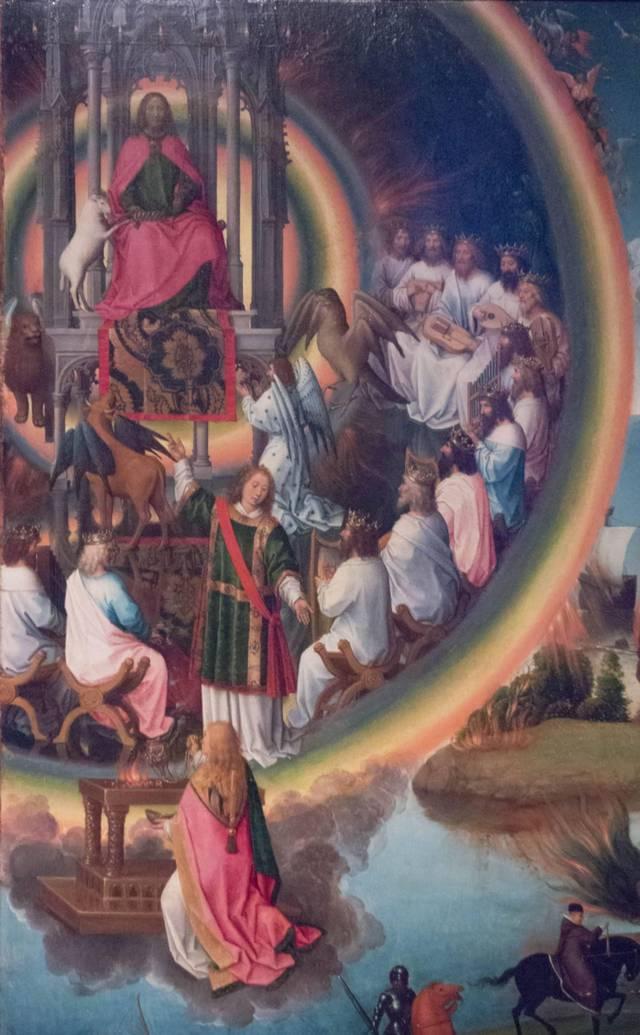
There was a rainbow around the throne(…)
the four living creatures(…)
a book written inside and outside, sealed shut with seven seals(…)
the elders, The Revelation, chapter 4 verses 2 to 8, chapter 5 verse 1, 6 to 7.
- The first creature was like a lion, and the second creature like a calf, and the third creature had a face like a man, and the fourth was like a flying eagle.
The four living creatures, each one of them having six wings, are full of eyes around and within. They have no rest day and night, saying,
“Holy, holy, holy is the Lord God, the Almighty, who was and who is and who is to come!”.
chapter 5
- I saw, in the right hand of him who sat on the throne, a book written inside and outside, sealed shut with seven seals.
- I saw in the midst of the throne and of the four living creatures, and in the midst of the elders, a Lamb standing, as though it had been slain, having seven horns, and seven eyes, which are the seven Spirits of God, sent out into all the earth.
- Then he came, and he took it out of the right hand of him who sat on the throne.
The Four Horsemen of The Revelation
The narrative continues between the rainbow and John.
first seal: the white horse - The Revelation, chapter 6 verse 2
chapter 6
I saw that the Lamb opened one of the seven seals, and I heard one of the four living creatures saying, as with a voice of thunder,
“Come and see!”
- And behold, a white horse, and he who sat on it had a bow. A crown was given to him, and he came forth conquering, and to conquer.
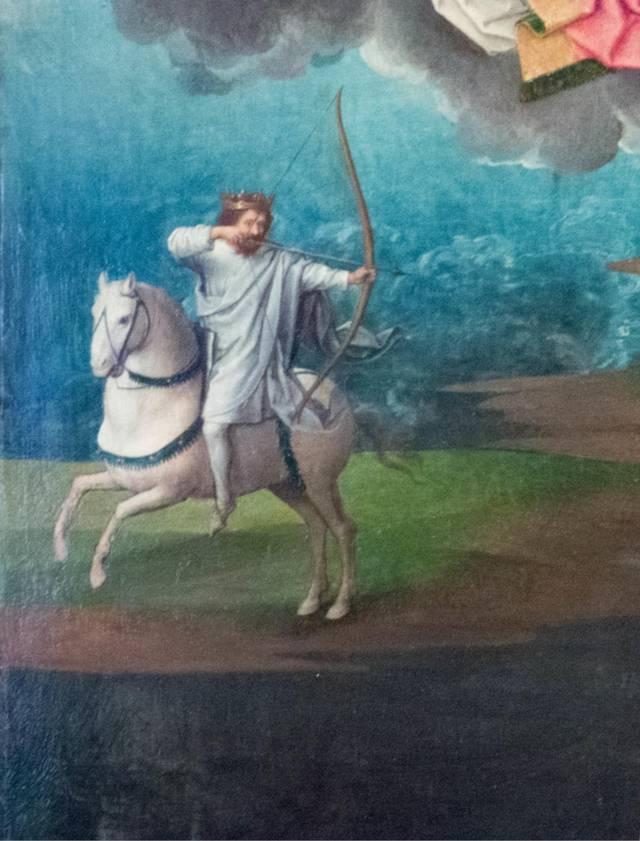
And behold, a white horse, and he who sat on it had a bow. A crown was given to him, and he came forth conquering, and to conquer, The Revelation, chapter 6 verse 2.
second seal: the fiery red horse - The Revelation, chapter 6 verses 3 to 4
When he opened the second seal, I heard the second living creature saying,
“Come!”
- Another came forth, a red horse. To him who sat on it was given power to take peace from the earth, and that they should kill one another. There was given to him a great sword.
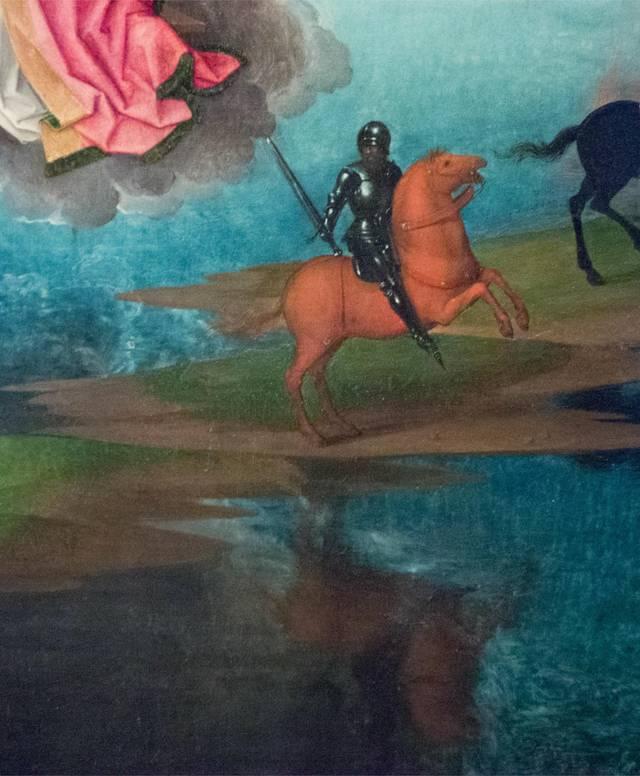
To him who sat on it was given power to take peace from the earth, and that they should kill one another. There was given to him a great sword, The Revelation, chapter 6 verses 3 to 4.
third seal: the black horse - The Revelation, chapter 6 verses 5 to 6
When he opened the third seal, I heard the third living creature saying,
“Come and see!”
And behold, a black horse, and he who sat on it had a balance in his hand.
I heard a voice in the midst of the four living creatures saying,
“Achoenix of wheat for a denarius, and three choenix of barley for a denarius! Don't damage the oil and the wine!”
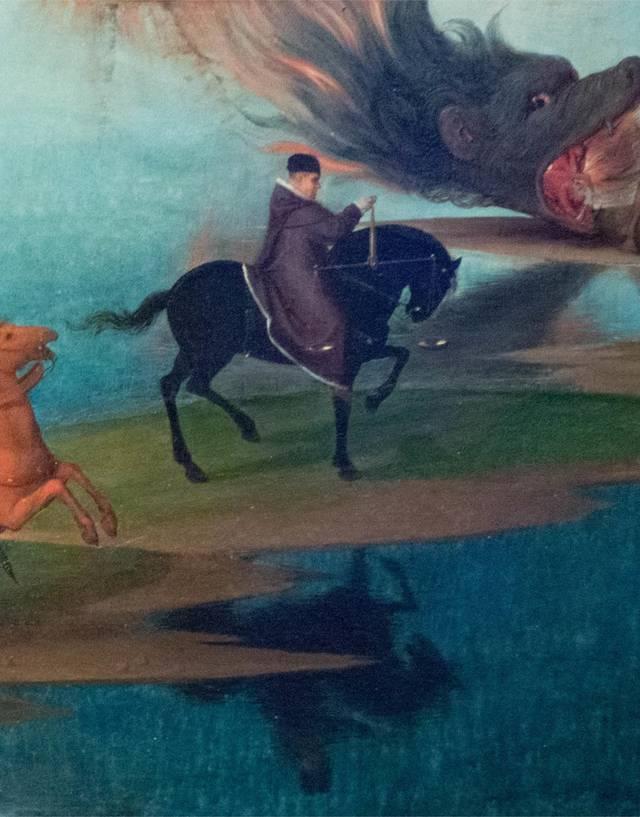
he who sat on it had a balance in his hand, The Revelation chapter 6 verse 5.
fourth seal: the greenish horse - The Revelation, chapter 6 verses 7 to 8
- When he opened the fourth seal, I heard the fourth living creature saying,
“Come and see!”
- And behold, a pale horse, and he who sat on it, his name was Death. Hades followed with him.
- Authority over one fourth of the earth, to kill with the sword, with famine, with death, and by the wild animals of the earth was given to him.
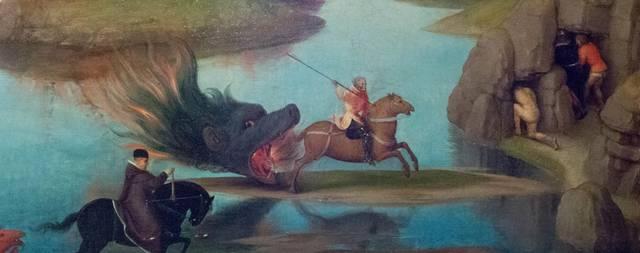
his name was Death. Hades followed with him, The Revelation chapter 6 verse 8.
landscape around the four horsemen - The Revelation, chapter 6 verses 14 to 17
- The sky was removed like a scroll when it is rolled up. Every mountain and island were moved out of their places.
- The kings of the earth, the princes, the commanding officers, the rich, the strong, and every slave and free person, hid themselves in the caves and in the rocks of the mountains.
They told the mountains and the rocks,
“Fall on us, and hide us from the face of him who sits on the throne, and from the wrath of the Lamb,
for the great day of his wrath has come; and who is able to stand?”
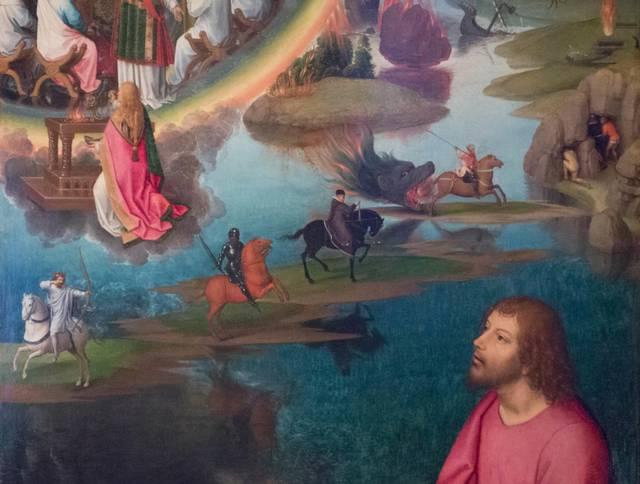
Every mountain and island were moved out of their places- The Revelation, chapter 6 verses 14 to 17.
the angels of the seventh seal - The Revelation, chapter 8 verses 1 to 2
chapter 8
- When he opened the seventh seal, there was silence in heaven for about half an hour.
- I saw the seven angels who stand before God, and seven trumpets were given to them.
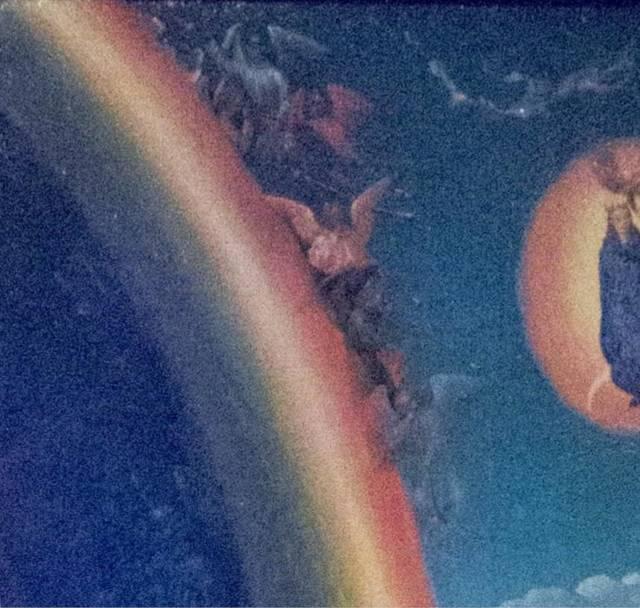
who stand before God, and seven trumpets were given to them, The Revelation, chapter 8 verse 2.
the angel of the altar - The Revelation, chapter 8 verses 3
- Another angel came and stood over the altar, having a golden censer. Much incense was given to him, that he should add it to the prayers of all the saints on the golden altar which was before the throne.
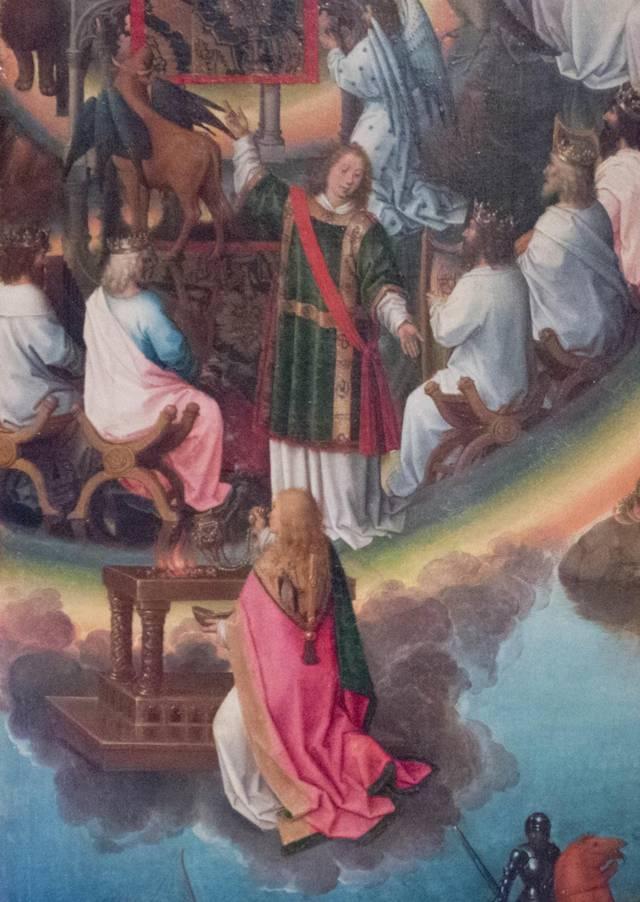
having a golden censer, The Revelation, chapter 8 verse 3.
- The smoke of the incense, with the prayers of the saints, went up before God out of the angel's hand.
- The angel took the censer, and he filled it with the fire of the altar, and threw it on the earth. There followed thunders, sounds, lightnings, and an earthquake.
fall of the great burning mountain - The Revelation, chapter 8 verses 6 to 9
- The seven angels who had the seven trumpets prepared themselves to sound.
- The first sounded, and there followed hail and fire, mixed with blood, and they were thrown to the earth.One third of the earth was burnt up, and one third of the trees were burnt up, and all green grass was burnt up.
- The second angel sounded, and something like a great burning mountain was thrown into the sea. One third of the sea became blood,
- and one third of the living creatures which were in the sea died. One third of the ships were destroyed.
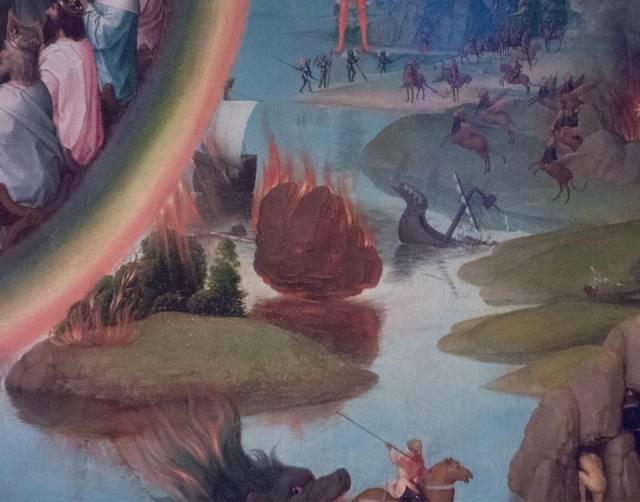
the fall of the "wormwood" star - The Revelation, chapter 8 verses 10 to 12
- The third angel sounded, and a great star fell from the sky, burning like a torch, and it fell on one third of the rivers, and on the springs of the waters.

a great star fell from the sky, burning like a torch(…) «One third of the waters became wormwood. Many people died from the waters, because they were made bitter», The Revelation, chapter 8 verses 8 to 12.
- The name of the star is called «wormwood». One third of the waters became wormwood. Many people died from the waters, because they were made bitter.
- The fourth angel sounded, and one third of the sun was struck, and one third of the moon, and one third of the stars; so that one third of them would be darkened, and the day wouldn't shine for one third of it, and the night in the same way.
the flight of the eagle - The Revelation, chapter 8 verse 13
I saw, and I heard an eagle, flying in mid heaven, saying with a loud voice,
“Woe! Woe! Woe for those who dwell on the earth, because of the other voices of the trumpets of the three angels, who are yet to sound!”.
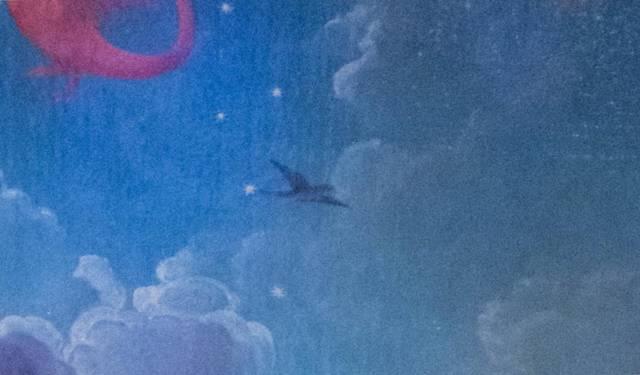
in mid heaven, The Revelation, chapter 8 verse 13.
the locusts' exit to the earth - The Revelation, chapter 9 verses 1 to 11
chapter 9
- The fifth angel sounded, and I saw a star from the sky which had fallen to the earth. The key to the pit of the abyss was given to him.
- He opened the pit of the abyss, and smoke went up out of the pit, like the smoke from a burning furnace. The sun and the air were darkened because of the smoke from the pit,
- Then out of the smoke came forth locusts on the earth, and power was given to them, as the scorpions of the earth have power.

power was given to them, as the scorpions of the earth have power, The Revelation, chapter 9 verse 3.
- They were told that they should not hurt the grass of the earth, neither any green thing, neither any tree, but only those people who don't have God's seal on their foreheads.
- They were given power not to kill them, but to torment them for five months. Their torment was like the torment of a scorpion, when it strikes a person.
- In those days people will seek death, and will in no way find it. They will desire to die, and death will flee from them.
- The shapes of the locusts were like horses prepared for war. On their heads were something like golden crowns, and their faces were like people's faces,
- They had hair like women's hair, and their teeth were like those of lions.
- They had breastplates, like breastplates of iron. The sound of their wings was like the sound of chariots, or of many horses rushing to war.
- They have tails like those of scorpions, and stings. In their tails they have power to harm men for five months.
- Their tails were like scorpions' tails, with stings,
- They have over them as king the angel of the abyss. His name in Hebrew is “Abaddon”, but in Greek, he has the name “Apollyon” (which means: Destructor).
the angel descended from heaven - The Revelation, chapter 10 verses 1 to 3
chapter 10
- I saw a mighty angel coming down out of the sky, clothed with a cloud. A rainbow was on his head. His face was like the sun, and his feet like pillars of fire.
- He had in his hand a little open book.
- He set his right foot on the sea, and his left on the land.
- He cried with a loud voice, as a lion roars.
- When he cried, the seven thunders uttered their voices.
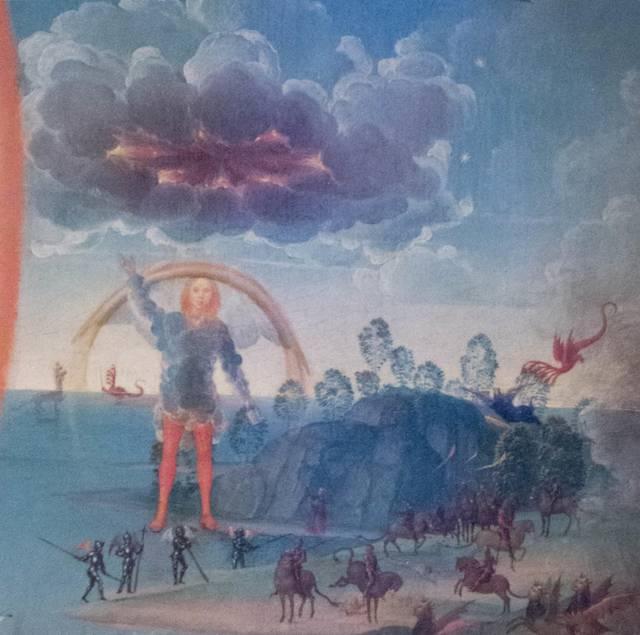
I saw a mighty angel coming down out of the sky, clothed with a cloud. A rainbow was on his head. His face was like the sun, and his feet like pillars of fire, The Revelation, chapter 10 verses 1 to 3.
The heaven of Revelation - The Revelation, chapter 10 verses 3 to 6
When the seven thunders sounded, I was about to write; but I heard a voice from the sky saying,
“Seal up the things which the seven thunders said, and don't write them.”
- The angel who I saw standing on the sea and on the land lifted up his right hand to the sky,
- and swore by him who lives forever and ever, who created heaven and the things that are in it, the earth and the things that are in it, and the sea and the things that are in it, that there will no longer be delay.
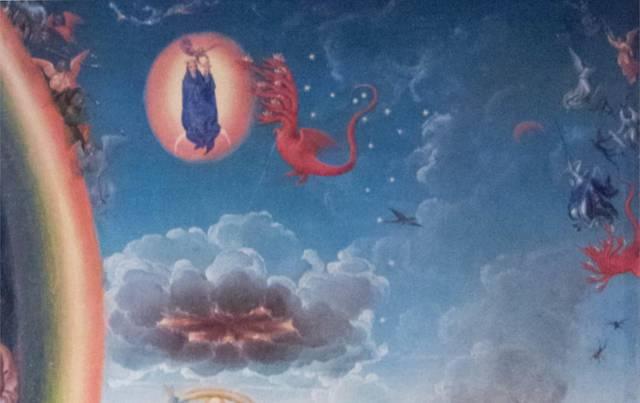
the seven thunders sounded, The Revelation, chapter 10 verses 3 to 6.
the woman and the dragon - The Revelation, chapter 12 verses 1 to 4
chapter 12
- A great sign was seen in heaven: a woman clothed with the sun, and the moon under her feet, and on her head a crown of twelve stars.
- She was with child. She cried out in pain, laboring to give birth.
- Another sign was seen in heaven. Behold, a great red dragon, having seven heads and ten horns, and on his heads seven crowns.
- His tail drew one third of the stars of the sky, and threw them to the earth. The dragon stood before the woman who was about to give birth, so that when she gave birth he might devour her child.
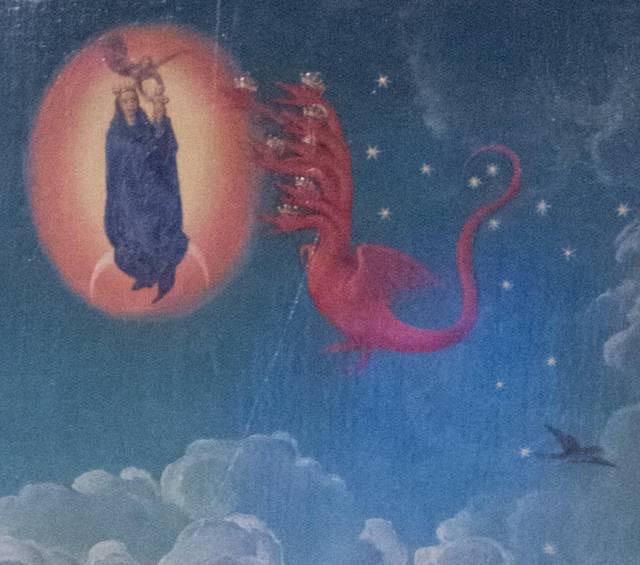
The dragon stood before the woman who was about to give birth, so that when she gave birth he might devour her child, The Revelation, chapter 12 verses 1 to 4.
battle of saint michael, the dragon and their angels: fall of the dragon and his angels - The Revelation, chapter 12 verses 5 to 9
- She gave birth to a son, a male child, who is to rule all the nations with a rod of iron. Her child was caught up to God, and to his throne.
- The woman fled into the wilderness, where she has a place prepared by God, that there they may nourish her one thousand two hundred sixty days.
- There was war in the sky. Michael and his angels made war on the dragon. The dragon and his angels made war.
- The dragon fought back with his angels,
- They didn't prevail, neither was a place found for him any more in heaven.
- The great dragon was thrown down, the old serpent, he who is called the devil and Satan, the deceiver of the whole world. He was thrown down to the earth, and his angels were thrown down with him.

He was thrown down to the earth, and his angels were thrown down with him, The Revelation, chapter 12 verses 5 to 9.
the woman receives two great eagle's wings to escape the dragon - The Revelation, chapter 12 verses 10 to 14
I heard a loud voice in heaven, saying,
«Now is come the salvation, the power, and the Kingdom of our God, and the authority of his Christ; for the accuser of our brothers has been thrown down, who accuses them before our God day and night,
now that the accuser, who accused our brothers day and night before our god, has been brought down.
They overcame him because of the Lamb's blood, and because of the word of their testimony. They didn't love their life, even to death.
Therefore rejoice, heavens, and you who dwell in them.
Woe to the earth and to the sea, because the devil has gone down to you, having great wrath, knowing that he has but a short time.»
- When the dragon saw that he was thrown down to the earth, he persecuted the woman who gave birth to the male child,
- Two wings of the great eagle were given to the woman, that she might fly into the wilderness to her place, so that she might be nourished for a time, and times, and half a time, from the face of the serpent.

that she might fly into the wilderness to her place, The Revelation, chapter 12 verses 10 to 14.
End of the visions of John on Patmos, continuation of the account of the legend of John the Evangelist according to chapter 9 of The Golden Legend
From the point of view of the narrative constructed by Memling, the visions of The Revelation end here.
The life of John the Evangelist continues, after Patmos, on the central panel, according to The Legend of John the Evangelist as told in chapter 9 of The Golden Legend.
resurrection of Drusiana - The Golden Legend, chapter 9
The narrative of the legend of John the Evangelist continues on the inner central panel, in the far right.
According to The Golden Legend, John then returns to Ephesus, where he resurrects Drusiana as Memling depicts him on a capital:
— «Drusiana, my Lord God Jesus Christ ariseth thee; Drusiana arise, and go into thy house, and make ready for me some refection.»
Anon she arose and went in to her house for to do the commandment of St. John, and the people made three hours long a great noise and cry, saying there is but one God, and that is he whom St. John preacheth.
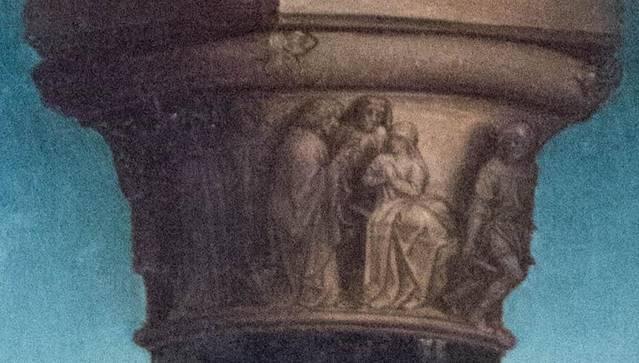
Anon she arose and went in to her house, The Golden Legend, chapter 9.
capital of the miracle of the poison cup - The Golden Legend, chapter 9
«If you want me to believe in your God, I will give you a drink of poison and if he does not hurt you, your lord will appear as the true God.»
He drinks the poisoned cup without suffering the slightest harm.
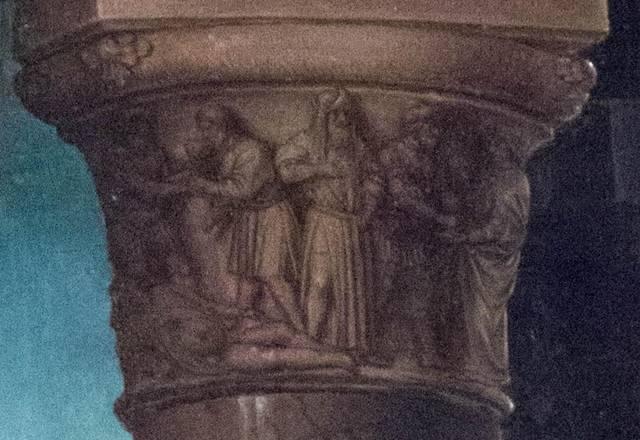
If you want me to believe in your God, I will give you a drink of poison and if he does not hurt you, your lord will appear as the true God., The Golden Legend, chapter 9.
Crato's baptism - The Golden Legend, chapter 9
At the very back, John the Evangelist baptizes the converted philosopher Crato
The apostle named in the name of Christ the priest and the proconsul, who converged with their entire family and then built a church in honor of St. John.
That small domed building can be seen as that church in honor of St. John
as told also in chapter 65.
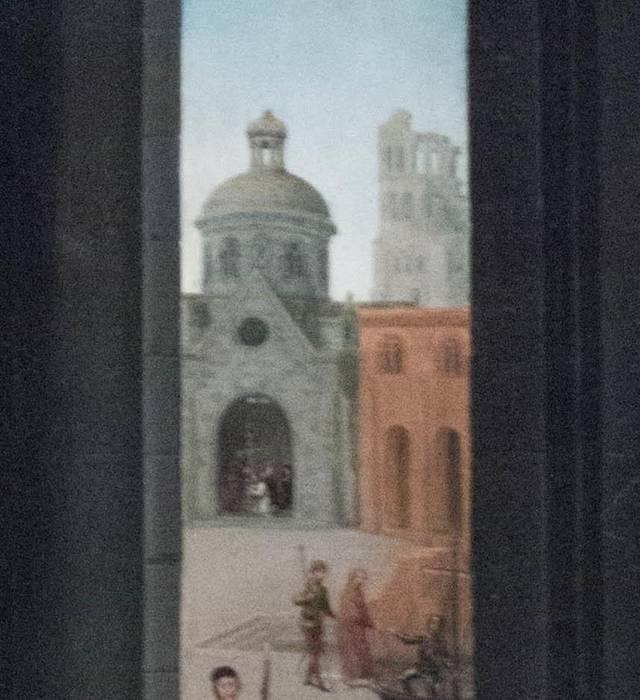
the apostle named in the name of Christ the priest and the proconsul, who converged with their entire family and then built a church in honor of St. John., The Golden Legend, chapter 9.

presentation of donors: the closed tryptich
The reverse sides of the shutters are decorated with portraits of the donors kneeling and accompanied by their standing patron saints.
They are represented in shallow niches.
All have been identified
We recognize, from left to right:
On the left shutter, from the left:
- Standing, St. Agnes, recognizable by the lamb below on the left side,
- Kneeling in front, Agnès CASEMBROOD kneeling.
to the right of the left shutter:
- Standing, St. Clare carries the thurible,
- Protects Sister Claire VAN HULSEN, kneeling in front.
On the right pane, from the left:
- Standing, Saint James the Great of Compostela dressed as a pilgrim,
- Known in front, Jacob DE KEUNINC
to the right of the right-hand panel:
- St. Anthony Abbot, who is recognizable by his crook and the piglet,
- patron of Antoine SEGHERS, master of the hospital.
The triptych was probably commanded before , since it was in that year that Antoine SEGHERS died.
It was placed above the master altar in .